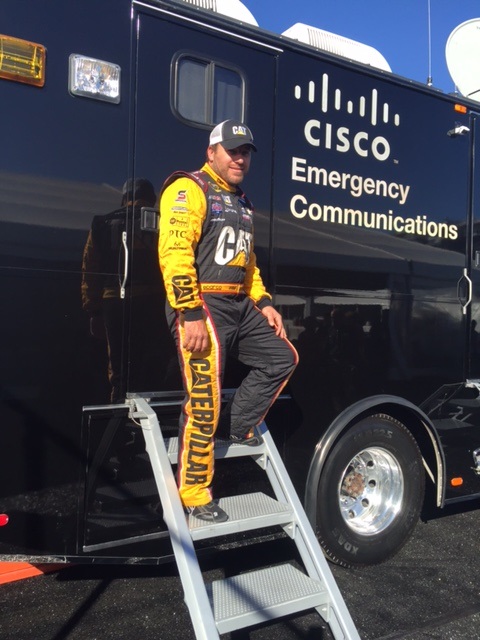The promise of digital transformation brings many important business outcomes and corporate strategies. A staggering majority of companies acknowledge that digital disruption is inevitable according to a recent Manufacturing thought leadership survey. With this disruption and transformation, there are some benefits to workers. In fact, I’m particularly passionate about the impact and improvements to worker safety and employee quality of life. These are specifically relevant to mining, manufacturing, and energy and any other verticals with harsh and rugged industrial work sites.
This came to life for me last week when I had the honor of working with our customer Caterpillar, at the Phoenix International Raceway Track. Ryan Newman, a top driver in NASCAR for the Caterpillar racing team was in Phoenix to move towards the next round of the Chase Sprint to the Cup. We invited Ryan try a new experience quite different from his typical driving at 200 mph. Instead, we had him driving one of the largest bulldozers in the world (at 230,000 pounds), a Cat D11T situated 150 miles away. Cars are flying by in the background while we walk Ryan through directions on how to driv e a remote bulldozer.
e a remote bulldozer.
You would think that a professional driver would know how to do this, but remote operation is very different. The initial joke was that Ryan had to do some right turns (in NASCAR it is a circular track with mostly a left turn for the vehicle to follow). Ryan of course made this look easy and hit the ground running. After his, and a few others, practice runs we started to describe the technical details that make this happen. We were not just driving from 150 miles away but the data is actually routed from the demo vehicle to the Cisco NERV truck over wireless, which then is connecting over one of a few options for connectivity (we are using a DSL modem with LTE and 3G connectivity as back up) back to Cat’s headquarters in Peoria, Illinois and then finally to the Tucson where the bulldozer was, a trip of over 3500 miles. And back again.
The video has to come in real time (with four camera views for maximum visibility) so that the remote driver can fully operate the features of the bulldozer. The impact of being able to remotely control machines and equipment is significant, reducing worker travel time (means more time at urban centers with family), exposure to dust, vibration or other conditions, not to mention reducing worker fatigue, possible accident or injury and other risks. In addition, the hundreds of sensors deliver key data for equipment predictive maintenance so that everything can be repaired before breakdown to maximize uptime. Impacting these areas truly delivers bottom line results for companies.
Cisco and Caterpillar have been working on this solution and installed our wireless access products (AP3700) onto the D11, work across the Cisco Mesh products (AP1750) to drive the information across. For more details check this video out on Caterpillar MineStar:
Our work with Caterpillar takes our Connected Machines strategy to a whole other level. From our partnerships with leading robotics manufacturer Fanuc and machine tooling leader Mazak, I’m excited to be part of a team impacting not just operational goals such as uptime and OEE but also critical human aspects such as worker safety and quality of life. What other applications can you see for remote operations in your environment? Leave me a comment below. Thanks for reading.
Very nice to see the collaboration between you two! Very funny NASCAR joke too, by the way! 🙂
Thanks for the note. There is a lot going on in the mining space, with the disruption the industry has had recently with pricing of commodities and the safety issues always in affect. Wait for more interesting new coming out soon
godjobs